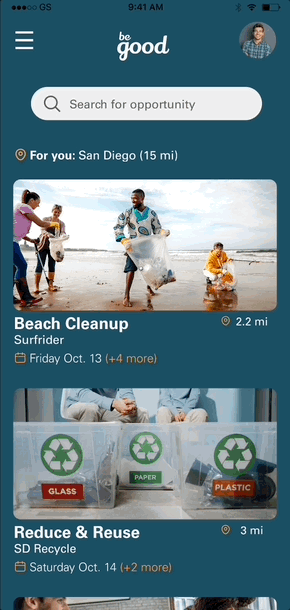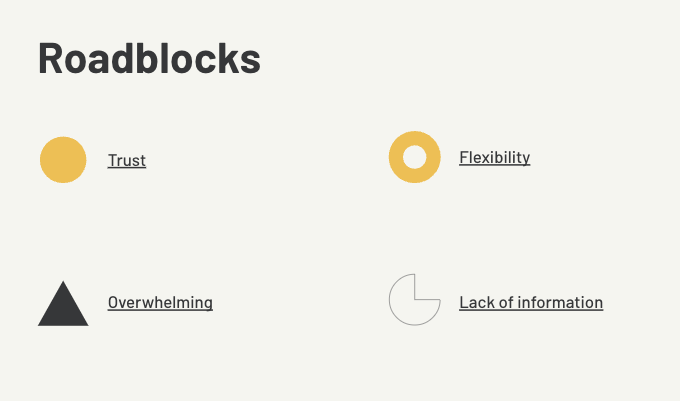Be Good
An app making giving more accessible and flexible
Creating shared experiences
Helping the community
Project Overview
Introduction & Problem
The goal of this project was to simplify volunteering and donating. I believe people are inherently good and more likely to volunteer and donate if they have immediate access to information and an easy registration process, especially if they can sign up with friends to make it a social even
The Problem is People who are looking to donate and volunteer need a place where they can find information easily, and register all in one.
Objective
Create an easier way to help people donate to causes in their area. Make volunteering/donations more accessible/automatic (what)
Designed for people who are looking to donate items and volunteer in lieu of financial donations (who)
People are inherently good and seek out to do good things but have trouble finding trustworthy resources easily/that fit into their schedule (context)
Present them with several (2-5) local options and information, Match skills and experience to roles that are available (goals)
We need to test* the assumption that people would actually donate if given an easier opportunity and ease of automatic connection and how they are motivated. (assumption)
Discovery
Research
Secondary Research
From my preliminary & secondary research I’ve found similar trends. People have a want or desire to give back by donation, but majority don’t.. That’s the problem I’m here to fix.
I wanted to start by looking into what motivates people to donate
I found there are three main motivations to doante
Emotions : Such as empathy seeing yourself in somebody else's shoes, the sad animals on being abused on tv,
Sympathy: giving a dollar to a homeless person on the street
Fear: environmental causes, they fear climate change
Anger: giving to one politician because you hate the other party so much
Social: Social givers are motivated by social dynamics. The power to invite others to join or gamify can create a sense of togetherness. Sharing on social media can boost reputation, but also allow others to invite or create a sense of FOMO. Social givers are motivated to donate as a form of community. Humans tend to seek out groups with similar values and interests to create a sense of belonging.
Personal Benefit: People in this category are motivated by a more personal gain. Tax benefits, boost their ego/reputation, maybe they need to volunteer to meet requirements for an academic program, or simply they just ‘feel good’ when they donate.
Most of my secondary reserach fit my hypothesis that the motivation to give is there but the behavior doesn’t match
A poll asking people why they don’t donate monetarily shows that
I looked into what was stopping people from donating on a regular basis:
Trust: people aren't comfortable donating if they don’t trust the organization, (this became a bigger issue through my research that I want to address when developing my project.)
Overwhelming: too many problems in the world, too many charities, google search for charity yields thousands of results
Flexibility: don’t have enough time, volunteer schedules are too inflexible
Don’t have enough information & most volunteer roles aren’t that interesting, jobs aren’t meaningful or have purpose people want purpose to feel good after volunteering
Surveys
I sent out a survey of my own to anyone who would take it. I had 39 people participate in the 24 hours it was live.
I asked people about their work schedule as well as free time and how much they volunteer vs how motivated they are to volunteer. The results were fairly similar to my secondary research; the motivation is there, however the action is not.
73% Work or study 35+ hours a week 7 have 11-30 hours of free time
“
73% Volunteered 4 times in the last 6 months
84% Were motivated to volunteer
When I asked the question “Is there anything preventing you from volunteering?” The main response I got was time followed by lack of information and visibility
“
Interviews
What interested me about this is that a good percentage said that they would donate time/goods/services in lieu of financial donations
I also asked if people would be motivated to volunteer with friends.. Majority of people said yes, they liked the idea of companionship, shared experiences, and comfort of not doing something alone. There were a couple outliers who were more motivated by the job at hand than the shared experience of doing something with friends.
From my screener survey I chose 5 individuals to interview. The participants all
Work 35+ hours with 11+ hours of free time
Motivated to volunteer but had less than 4 times in the past 6 months
3 who answered time was the roadblock and 2 who said lack of inormation
“
“
I interviewed participants about their current lifestyle, what a typical week looks like, what their hobbies/interests are.
How often they donate or volunteer and where they find those opportunities.
I asked how motivated they were by a potential social aspect, if they would be more likely to volunteer with a group of friends and how often they post about fundraisers/volunteer events on social media.
I also asked about some roadblocks, what makes an organization trustworthy and how important that is and how far they would go to find that out or research something for a donation.
Thematic Analysis
Daily Lives
Hanging out with friends is something already done in the free time people have
Most or all said they would volunteer with a cause related to hobby (one said as long as it would be helpful)
Who/How
A lot of volunteer opportunities are presented through work or family
Many places they chose to volunteer or donate had to do with personal causes close to home, empathy related choices (i.e. animal shelters), or with/for a person they respected.
People tend to donate to online charities based on the person who posted it, they trust/love/want to support that person.
Transparency major factor
Transparency is important.
How nonprofits utilize funds is important.
Find it difficult to find transparency, would not donate/be more hesitant if you couldn't find it.
Well known charities tend to hold more trust with people, reputation is big.
Connection
Everyone said volunteering makes them feel good, but some said they wish they could do more in terms of feeling like they have an actual impact on the issues they’re helping.
Drawn to the idea of volunteering with friends in lieu of current social activities like going out to bars/restaurants.. The idea of “creating new experiences” with friends was attractive.
Search
Everyone is guilty of throwing away items they could donate.. Usually based on not having time or knowledge of where to take it.
Results were mixed as far as how much research people would do to find a place to look to donate, but the majority hadn’t looked/wouldn’t look too hard.
Majority mentioned throwing a lot of items together and taking to the goodwill/salvation army out of convienece.
Define
How Might We & Personas
From this research I came up with some How Might We questions and Personas to keep in mind the goals and end user
How might we create a platform that makes donating time/money more accessible.
How might we provide a flexible schedule and provide as much trustworthy information as possible.
How might we turn giving into an experience that can be shared and remembered with friends.
How might we gamify a system where people are rewarded for doing good.
How might we simplify the research involved in choosing a charity to donate to.
Features & Flows
User Flows
I mapped out some key features and flows that I wanted to include on the app then turned those into User Flows
Design
Sketches
My initial sketches included a lot more of the onboarding, being able to customize a profile with interests. This turned out to be too overwhelming, and lost focus of the goal; to create an experience of signing up for a volunteer/donation.
With a fresh perspective, I reduced the clutter and confusion, and simplified everything for a more accessible and user-friendly experience.
I had the idea to be more graphic/icon forward however this lead to some accessibility issues in the UI design phase, so I decided to eliminate some of the graphics, in a future version I’d like to add more graphics/icons however they weren’t as important to get to the MVP.
Design System
I chose the Univers typeface because I wanted a sans serif type with rounded edges. Univers to me reads as playful, but still easily legible.
I want my color pallet to evoke an energetic, inspiring and inclusive experience. The use of bright colors will make the experience of donating more exciting to the consumer.
High Fidelity Designs
User Feedback
I did a final round of user testing with my high fidelity prototype and while the users were able to navigate and completle the task, some feedback I received was users would prefer to see some initial welcome landing page which can be added at a further date.
Another recommendation was to have a receipt at the end of any monetary donation.
The feedback I got later on about the UI was that it was basic, but able to be understood and used and for me, coming from a graphic design background, this was difficult to get past the lackluster UI and focus on usability and accessibility..
Challenges & Learnings
Prototypes
Embarking on my first UX project was like diving into a sea of endless options, both thrilling and overwhelming. Without any constraints, the blank canvas felt more like a void than an opportunity. It taught me that I work best when there's a roadmap to follow, where constraints act as guiding stars, illuminating the path ahead. This experience highlighted the importance of structure in fueling my creativity within the realm of UX design.
Be Good presented a steep learning curve, particularly in conducting user interviews for research and navigating tools like Figma. Rather than fixating on perfecting the UI, I embraced the process, prioritizing usability and accessibility. This shift in focus illuminated the essence of UX design: understanding user needs and crafting experiences that prioritize functionality over aesthetics. It taught me the value of adaptability and the importance of user-centric design principles in creating meaningful solutions.
In the future, I’d like to come back and add more graphics/imagery to the UI as well as some aspect to gamify the design. The idea and researched proved that it could be something great and I’m excited to explore where it could go in the future!
Instant Volunteer Sign up
Item donation registration via search with keywords
Monetary Donation via search





